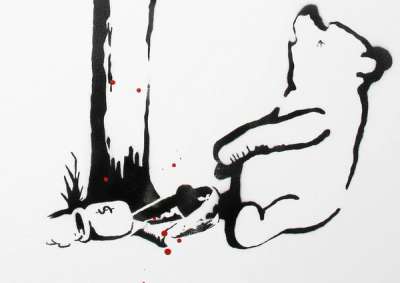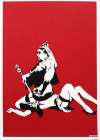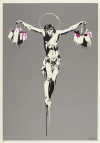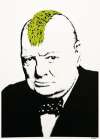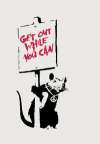Winnie
the Pooh
Banksy's Winnie the Pooh sees A. A. Milne's beloved character caught in a trap. Red paint splatters the monochrome work, and Pooh's honey pot is replaced with a money pot. A common theme of Banksy’s, the implied corruption of childhood innocence underlines the insidious ‘trap’ that is capitalism.
Banksy Winnie the Pooh for sale
Sell Your Art
with Us
with Us
Join Our Network of Collectors. Buy, Sell and Track Demand
Meaning & Analysis
Banksy’s Winnie the Pooh image first appeared in 1999 as an in situ work, stencilled onto a wall in the artist's hometown of Bristol. This particular print edition, sometimes referred to as Pooh Bear, was created in 2003 and is part of a series of 25 Winnie the Pooh canvas prints.
Winnie the Pooh belongs to Banksy’s earliest collection of canvas-based works, and was first displayed at Santa’s Ghetto - an exhibition of paintings and prints by Banksy and other artist including Eine, Dface and Space Invader. During the 2000s, this exhibition opened every December in different locations around London. The second edition of Santa’s Ghetto, in 2003, took place in an abandoned store just off Carnaby Street, drawing an international and star-studded crowd.
The second series of Winnie the Pooh canvas editions appeared in 2013 in New York, on the occasion of Banksy’s month-long street residency in the city, known as Better Out Than In. On day 13 of the show, the artist – disguised as a typical street vendor – set up a stand in Central Park where he sold black and white editions for just $60. With the artist’s identity concealed by a disguise, only eight of the works were sold.
The following day, in true Banksy style, the artist authenticated those canvases on his website declaring, ‘Yesterday I set up a stall in the park selling 100% authentic original signed Banksy canvases. For $60 each’.
The work features English author A.A. Milne's famous Winnie the Pooh character. Banksy’s rendition is based on Ernest Howard Shepard's original cuddly bear illustration and depicts Pooh as a stencilled black and white figure in spray paint on canvas. The much-loved bear is pictured weeping under a tree, his foot caught in a bear trap. In place of Pooh Bear’s famous honey pot is a pot of money, lying on the ground next to him.
Milne's famous teddy bear, known for his naivety and good nature, is a universal symbol of childhood innocence. Banksy's rendition is a depiction of the loss of that innocence, with Pooh’s honeypot transformed into a symbol of wealth and materialism.
